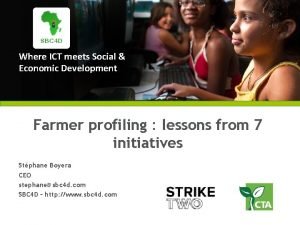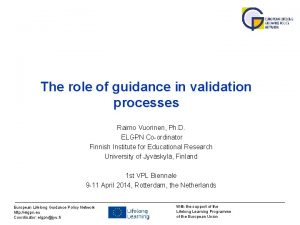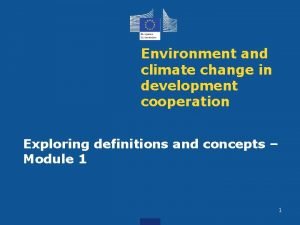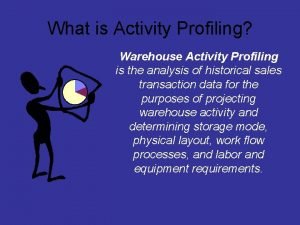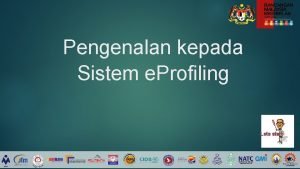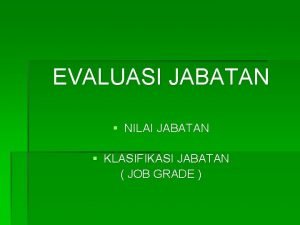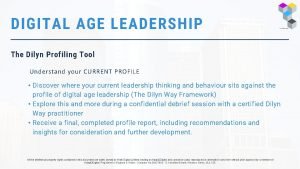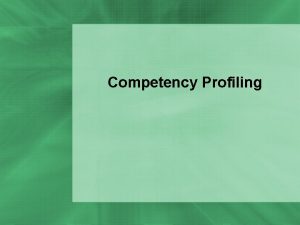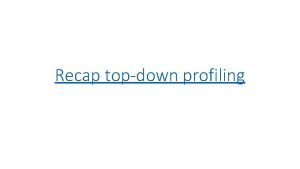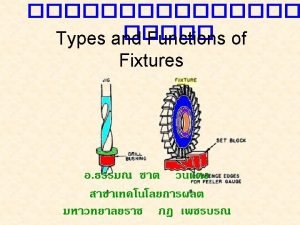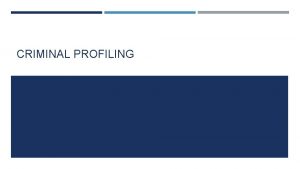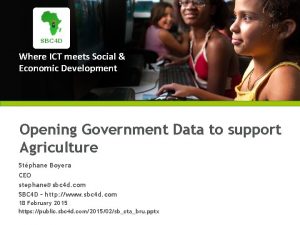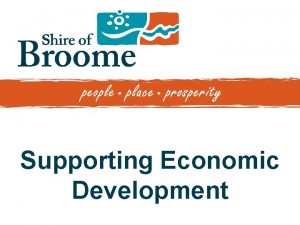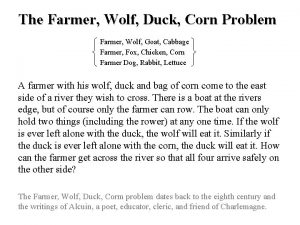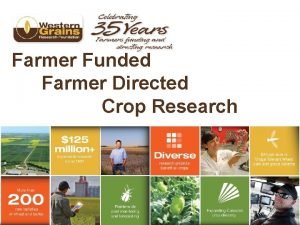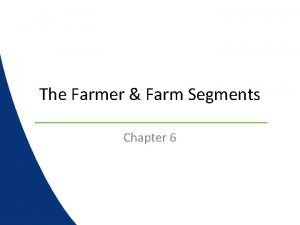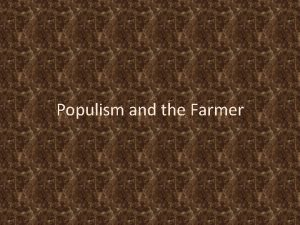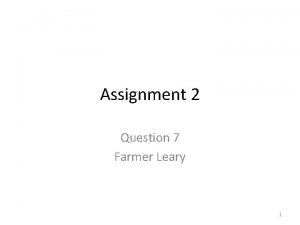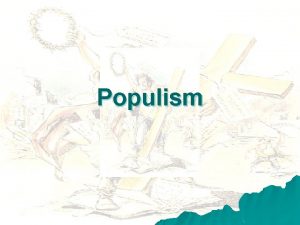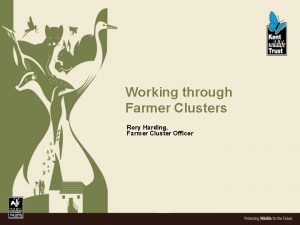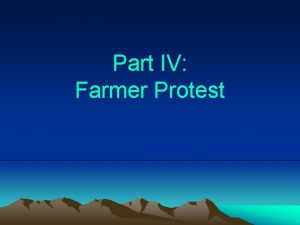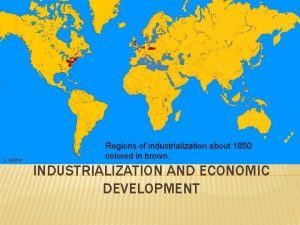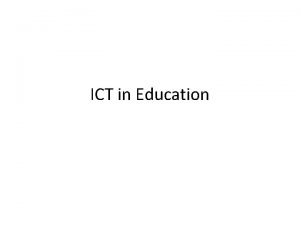Where ICT meets Social Economic Development Farmer profiling


























- Slides: 26

Where ICT meets Social & Economic Development Farmer profiling : lessons from 7 initiatives Stéphane Boyera CEO stephane@sbc 4 d. com SBC 4 D – http: //www. sbc 4 d. com

Overview o SBC 4 D experience in Farmer profiling o Introduction to Farmer profiling o CTA Data 4 Ag experience o Main lessons & Best practices SBC 4 D – http: //wwww. sbc 4 d. com 2

SBC 4 D: Where ICT meets Social & Economic Development o Consulting Company specialized in ICTD since 2009 o Mobile & Web services: Strategy, design, implementation, deployment. Specific expertise on multi-channel applications, and ICT for illiterate underprivileged communities o Open Data & Open Linked Data: Strategy & Implementation o Sector Expertise: primarily Agriculture, but also Governance, Media, Health o ICT 4 Ag: farmer profiling, AMIS, business matching, insurance, communication (IVR, CC, etc. ) o Major clients: Governments, Development agencies (USAID, MCC, …), UN (ITC, UNDP, FAO, IFAD, etc. ), WB, EU (CTA, …) private foundations & NGO (Care, BMGF, …), private sector (Orange, MTV, Al Jazeera, …) o Geography: 70% of activities in Sub-Saharan Africa, Operation in South Asia (India, Vietnam, Bhutan, Indonesia), Pacific Islands (Fiji), Latin America (Chile, Colombia) SBC 4 D – http: //wwww. sbc 4 d. com 3

Principles of Farmer Profiling SBC 4 D – http: //wwww. sbc 4 d. com 4

Principles of Farmer Profiling (2) SBC 4 D – http: //wwww. sbc 4 d. com 5

Services leveraging farmer profiles SBC 4 D – http: //wwww. sbc 4 d. com 6

Farmer profiling expected impact o Better policy based on real data o More advocacy power for Farmer Organizations o Greater access to financial services by smallholder farmers o Easier access to extension and trade services Ø Greater yields Ø Greater income SBC 4 D – http: //wwww. sbc 4 d. com 7

Building blocks o Profile content o Which information needed for which services? o Data collection and update model o Technical platform o Business model SBC 4 D – http: //wwww. sbc 4 d. com 8

CTA Data 4 Ag initiative o A joint initiative with PAFO and Agricord since 2016 o Objective: Support FOs to take advantage of new data-driven services o Implementation: funding of a series of FOs across Africa to test various technologies o This study: Review the farmer profiling component of 7 projects SBC 4 D – http: //wwww. sbc 4 d. com 9

National Union of Coffee Agribusiness and Farm Enterprises (NUCAFE) o o Almost 19. 000 farmers Main objective: o digitization of membership o New services: Value chain support and access to credit Profile use: o Work at individual farmer level (training needs…) o Geographical Indication & Certification (fair trade, organic) o Traceability o Advocacy and global impact measurement Main output o Increased farmer production o Increased coffee revenue for farmers (GI, Traceability) o Better position of collection points SBC 4 D – http: //wwww. sbc 4 d. com 10

Igara Growers Tea Factory (IGTF) o Almost 20 k farmers and more than 22 k gardens profiled o Profile use: o Input calculation o Access to credit o Main success o o o Saving for IGTF on inputs More farmers delivering to IGTF Better position of delivery points Easier access to credit for farmers Greater trust from farmers SBC 4 D – http: //wwww. sbc 4 d. com 11

FÉDÉRATION DES PROFESSIONNELS AGRICOLES DU BURKINA (FEPA/B) o 2053 farmers profiled o Main focus: FEPA/B advocacy o Main output: Data collection capacities within FEPA/B o Future use o Access to cheaper inputs o Market Linkages o Challenges: o Business model o Benefit/cost ratio o Scale-up SBC 4 D – http: //wwww. sbc 4 d. com 12

Confédération des Associations des Producteurs Agricoles pour le Développement (CAPAD) o o o Joint initiative with Collectif Stratégie Alimentaire 14153 farmers from 39 cooperatives profiled Main objective: support smallholder farmers in production and selling of agriculture products Profile use: help CAPAD provide better on-time services (input provision, credit) to their members Main output: o More cooperatives are able to sell product to WFP schools cafeteria program o Cooperatives have data to support dispute resolution with the Tax authority o More advocacy power for CAPAD Main challenges: Technical platform (offline capabilities) SBC 4 D – http: //wwww. sbc 4 d. com 13

Eastern Africa Farmers’ Federation (EAFF) o Approx. 190. 000 farmers in Kenya and 14. 000 in Uganda profiles o Profile use: o o Access to credit Access to cheaper input (group buying) Market linkages (group selling) E-extension o Output o o Greater revenue for farmers Access to larger credit for farmers Greater advocacy power for EAFF Design of a future business intelligence service for EAFF o Challenge: credit interest rates SBC 4 D – http: //wwww. sbc 4 d. com 14

Swaziland National Agriculture Union (SNAU) o Joint initiative with SACAU o Approximately 23. 000 farmers profiled o Main objective: digitalize farmer union membership management o Main output: o o Better understanding of membership Partnership with Mo. A to implement the national subsidy scheme for Maize via e-voucher system o Profile use: o o o Direct communication Policy studies Advocacy o Challenges: o o Business model Technical platform SBC 4 D – http: //wwww. sbc 4 d. com 15

Lesotho National Farmers Union (LENAFU) o o Joint initiative with SACAU 52000 farmer profiled Main objective: digitized LENAFU farmer registry Main output: o o Data collection capacities Access to new opportunities thanks to data & capacities: Partnership with WFP and with Mo. A & FAO o Profile use: o o o Communication with members Design new services for members Business intelligence service o Challenges o o Business model Technical platform SBC 4 D – http: //wwww. sbc 4 d. com 16

Lesson 1: Profiling is beneficial to all FOs o FOs acquired ICT and data collection skills that are valuable in the country and open doors for new opportunities o Profile repository contains useful data that can be used for other purposes than the one primary objective SBC 4 D – http: //wwww. sbc 4 d. com 17

Lesson 2: Sustainability comes from financial impact of profiling task o o 3 over 7 projects did not continue the process after project funding due to cost/benefit ratio Successful projects make farmers proactive in provision of profile information o Require a critical mass of profiled farmers o Require the delivery of financially impactful services to farmers Reinforcing FO advocacy power is not a strong-enough incentive o Growing fatigue among farmer and resistance to numerous data collection that does not provide any output to them Sustainability also relies on low operational costs o Almost all Saa. S model have been dropped after the end of the project SBC 4 D – http: //wwww. sbc 4 d. com 18

Lesson 3: Personal Data Protection legislations have a major impact on profiling o o Only few FOs are aware of the need to comply to PDP regulations o Some are infringing laws on data hosting, declaration, capture of consent, … PDP best practices are useful to o Leverage trust among farmers o Prepare FOs for change in legislation PDP impacts many components o Software and hosting o Training of enumerator o Data collection setup o Profile data use PDP best practices have to be considered at the earliest possible stage of such projects SBC 4 D – http: //wwww. sbc 4 d. com 19

Lesson 4: no free and open-source reference technical platform for farmer profiling o o Almost all projects were facing challenges with the technical platform o Financial o Technical o Legal Profile information is useful for other services (credit, value chain development, etc. ) with their own platform. Profile information should be a pluggable module There isn’t any free and open source package with all functionalities o Some reference module (e. g. ODK) o Some fully-integrated solutions (e. g. blue number) A promising initiative from CSA/CAPAD project: PUMA 2 published on Framagit o Need further investment and the development of a community SBC 4 D – http: //wwww. sbc 4 d. com 20

Lesson 5: Profile content should be designed through a multi-stakeholder process o Different stakeholders and different services require different types of data point o The sustainability of a profiling platform depends on the number of users of profile information o Some services/stakeholders require specific data collection and verification process that needs to be included in the data collection and update model SBC 4 D – http: //wwww. sbc 4 d. com 21

Lesson 6: Profile data update is problematic o Organization of a census-type activity is costly but relatively easy o Such approach does not fit with quarterly or even annually update o Options o Self-update process through mobile o How to validate? o Use existing structure and network to update and validate information: o Collection points o Extension agents o … SBC 4 D – http: //wwww. sbc 4 d. com 22

Lesson 7: Potential of business intelligence services on top of profile data? o Almost all projects foresee potential revenue linked to BI service on top of profile data o None have successfully demonstrated the viability of this hypothesis o Require a detailed market analysis to identify products and customers o Require data analytics/data science expertise Ø This area needs further investigations SBC 4 D – http: //wwww. sbc 4 d. com 23

Conclusion o The output of the 7 projects are quite homogeneous in terms of challenges and in terms of opportunities o All FOs involved had a direct outcome (e. g. securing new projects) from the profiling activity o The sustainability of such approaches is hard to achieve and rely on the farmers active contribution in the process. Such contribution occurs when there is a clear direct benefit for them Ø Profiling is a tool to implement services for farmers and is not a goal. o The domain requires further investigation and development: o An open source package for the technical platform o Exploration and validation of BI service on top of profile data SBC 4 D – http: //wwww. sbc 4 d. com 24

Références o CTA Working Paper “Farmer profiling: Making data work for smallholder farmers”: https: //www. cta. int/en/digitalisation/article/farmerprofiling-making-data-work-for-smallholder-farmerssid 08 ef 124 c 5 -a 521 -4128 -b 7 dd-db 108 d 223250 o DIGITAL FARMER PROFILES: Reimagining Smallholder Agriculture. Landscaping Study, USAID, Grameen Foundation: https: //www. usaid. gov/digitalag/documents/datadriven-agriculture o CTA Experiences : https: //www. cta. int/en/digitalisation/all/article/ag ricultural-data-systems-to-transform-smallholderfarming-sid 0 ec 4 b 7362 -20 bc-476 f-b 0 ad-3 fe 3 d 5 a 4 aa 24 SBC 4 D – http: //wwww. sbc 4 d. com 25

Copyright © 2011. World Wide Web Foundation. All rights reserved
 Farmer profiling
Farmer profiling Economic growth vs economic development
Economic growth vs economic development Growth and development conclusion
Growth and development conclusion Economic social development
Economic social development Economic social development
Economic social development Lesson 2 our economic choices
Lesson 2 our economic choices Global agenda for social work and social development
Global agenda for social work and social development Social thinking adalah
Social thinking adalah Social thinking social influence social relations
Social thinking social influence social relations Warehouse profiling
Warehouse profiling Demerits of learner profile
Demerits of learner profile Spokesperson
Spokesperson Priling
Priling Sexual offender map
Sexual offender map Channel partner profiling
Channel partner profiling Google wide profiling
Google wide profiling Nilai jabatan adalah
Nilai jabatan adalah Leadership profiling tools
Leadership profiling tools James russell odom and james clayton lawson
James russell odom and james clayton lawson Gather approach in family planning
Gather approach in family planning Competency profiling process
Competency profiling process Ase profiling
Ase profiling Top-down vs bottom-up profiling
Top-down vs bottom-up profiling Top-down approach psychology
Top-down approach psychology Qnx memory usage
Qnx memory usage Brianmac scat test
Brianmac scat test Define and classify fixtures.
Define and classify fixtures.
